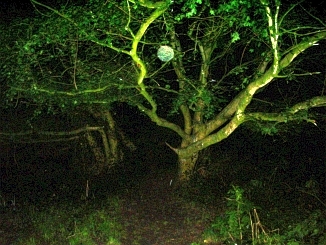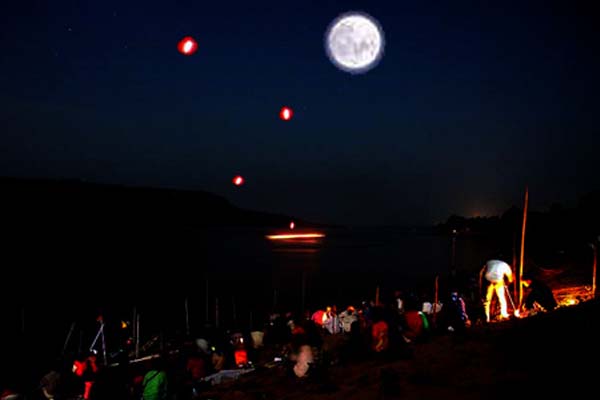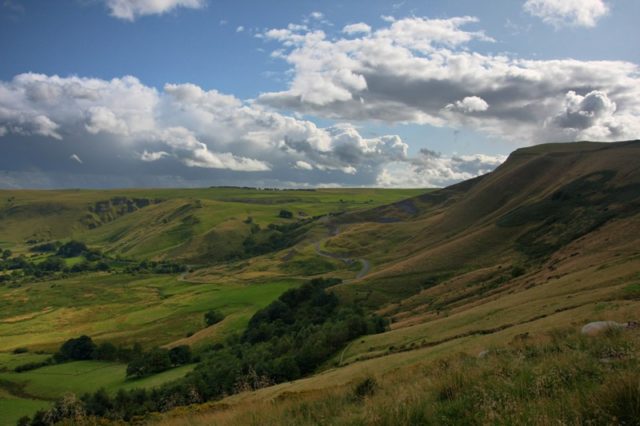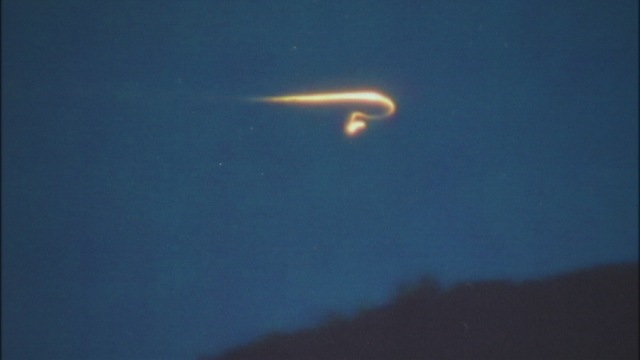Among the plethora of curiosities that make our world the mysterious place it is, one of the most interesting are so-called “spook lights.” These little balls of light, usually blue in color, appear at a particular locale and serve as the basis for many a spooky tale. What makes this phenomena so different from other alleged paranormal activity is that these lights appear on a fairly regular basis and have been photographed, filmed, and even studied by scientists. As such, that they exist is not in doubt.
What they are, however, is another story. Some insist that they’re manifestations of paranormal energy, ghosts, UFOs, or some other kind of other-worldly phenomena, while more scientifically-minded people maintain that they’re either examples of ball lightning, swamp gas or simple misidentification of traffic or train lights. Some even suggest that they’re a byproduct of plate tectonics, fault lines or some other geological anomaly, making them even more mysterious. Whatever they are, no one can deny their beauty and exotic nature, or the fact that they obstinately defy all attempts to explain exactly what they are.
10. Gurdon Spook Lights, Arkansas
Drive 75 miles south of Little Rock and turn east onto Highway 67 and you’ll be in the little town of Gurdon, home of the mysterious “ghost lights” that haunt a local stretch of railroad track about two miles out of town. Seen for more than 80 years, some claim it’s the ghost of a man who was brutally murdered near the tracks back in 1931. Others claim it’s the ghost of a railroad employee who fell onto the tracks and was decapitated back around the turn of the century, and that the light is actually his lantern that he’s using while he searches for his head. (This particular tale appears to serve as the basis for various spook lights around the United States, suggesting an urban legend is afoot.)
Killjoys, however, suggest that it may be nothing more than quartz crystals emitting electricity, although they’re not certain exactly how or why it happens. In any case, the lights are best seen on especially dark and overcast nights when, apparently, “ghosts” are most likely to be prowling about. And now you have a reason to visit Arkansas.
9. Silver Cliff Cemetery Lights, Colorado
First spotted in 1882, these silver-dollar sized bluish white lights are infrequently seen dancing around headstones at the Catholic cemetery on the outskirts of this tiny little town just west of Pueblo, Colorado. What’s interesting about these particular lights is that unlike most ghost lights — which are usually solitary phenomena — these appear in clusters of up to four or five at a time. They’re also considerably smaller than most other spook lights, which tend to be about the size of a basketball.
Like most ghost lights, however, they’re impossible to chase down as they quickly fade and disappear. The lights gained an unusual degree of fame when they were featured in an August, 1969 National Geographic article, giving it something of a scientific pedigree. While various theories have been put forward to explain them, none have stood up under scrutiny, leaving the Silver Cliff Cemetery Lights as unexplained today as they were a century ago.
8. Ghost Lights of the Yakima Indian Reservation, Washington State
The glowing whitish-orange orb that began appearing to forest rangers and fire watchers near Toppenish Ridge in the late 1960s were at first dismissed by local authorities as just a trick of the light, but all that changed when chief fire-control officer Bill Vogel not only spotted the thing himself, but took numerous photos of it as it danced and raced among the trees. What’s most interesting about the light is that, according to Vogel (who had the chance to observe the phenomena through binoculars for nearly 90 minutes before it finally disappeared) is that it had what appeared to be a mouse-like tail or antenna protruding upward from the top of it.
The antenna, as long as the object itself, was segmented into colors of red, blue, green and white which were constantly changing brilliancy and hue, leading many to assume it was possibly mechanical — or even extraterrestrial — in nature. As a result, it soon came to the attention of the UFO community and was even investigated by none other than the famous ufologist J. Allen Hynek, who concluded that the lights were inexplicable. Today the sightings are far less frequent, suggesting that whomever or whatever is behind the mysterious lights may be growing tired of their little experiments and are content to move on.
7. The Hessdalen Lights, Norway
First observed in 1981, these strange white lights that appeared periodically in a small valley near the town of Hessdalen, Norway, so concerned residents of the area that they tried to get the Norwegian government involved. Alas, no official within the government was willing to do anything, leading several researchers to organize their own scientific study of the phenomena, which they dubbed the Hessdalen Project. It proved to be successful, unusually so for such ventures — in just one month in 1984 investigators spotted the mysterious lights no fewer than 53 times, making it one of the most reliable ghost lights in existence. The lights are still being observed in the Hessdalen Valley to this day, though their frequency has decreased dramatically. In any case, an automatic measurement station set up overlooking the valley in August 1998 still manages to record about 20 sightings a year.
6. The Hornet Spook Light, Hornet, Missouri
Travel a short distance west of Joplin, Missouri on Interstate 44 and you’ll find one of the more reliable and unusual spook lights, the famous Hornet Lights. Not only does it appear with some frequency, but it’s unusual in the fact that it not only changes colors, but has been seen to split apart, fly around and even leave a phosphorescent trail. Extensively studied and photographed since its first appearance in 1881, all attempts to explain it away as swamp gas, a luminous fungus, plasma, ball lightning, optical illusions caused by headlights on Interstate 44 and lights flashing off a distant water tower have all been debunked, leaving the mysterious lights as inexplicable now as they were when first spotted.
One of the more common — and romantic — metaphysical explanations is that the light is the spirit of a young Quapaw brave and his bride who plunged to their deaths from a nearby bluff to avoid facing punishment from their tribal chief, who forbid the marriage. On the other hand, it may be nothing more than a firefly with an attitude.
5. Fireship of Baie des Chaleurs, Chaleur Bay, Newfoundland & Labrador, Canada
Instead of appearing as an orb of light, this particular luminous glow appears as an arc, with some people affirming that it takes on the form of a burning eighteenth-century three-masted schooner, making it a full-fledged ghost ship. Since it generally appears just before the arrival of a storm, some have suggested the phenomena may have something to do more with static electricity in the air than the paranormal, although other explanations, from rotting vegetation to undersea releases of natural gas, have also been suggested.
On the other hand, perhaps it has something to do with a little known naval battle between French and British squadrons that took place in the vicinity of La Baie des Chaleurs around 1760; not only did the skirmish result in a French defeat, but one of the small warships the French lost may have inadvertently created a supernatural manifestation in the process.
4. Longdendale Lights, Derbyshire, England
When a place is known by the locals for centuries as a “haunted valley” it’s a good bet something spooky is going on, and that’s definitely the case for this quaint, remote valley in northern England. Also called “The Devil’s Bonfire,” these eerie, flickering lights have been known for centuries and have been attributed to everything from fairies and witches to torch-bearing ghosts of Roman soldiers. These reports are so persistent that Mountain Rescue teams in the area have turned out on a number of occasions when lights and ‘flares’ have been reported to the police, only to find that the lights fade away as they approach. This particular spook light is also unique in being one of the oldest known to exist, with reports going back to medieval times. In fact, reports have been going on so long that police no longer pass on sightings of mystery lights to unless they feel it’s a genuine sighting of a real distress flare.
3. Naga Fireballs, Mekong River, Thailand
Each year some 200 to 800 fiery orbs are sighted along a 60 mile stretch of the Mekong River between Thailand and Laos, usually in the late autumn months, and especially in October during a full moon. Local tradition maintains that the fireballs are from the Naga, a serpent from Buddhist legend, though modern science naturally disputes such claims, preferring a more pedestrian explanation such as natural phosgene and methane gas being released from the river. In any case, they generally appear shortly after sunset and are frequently seen by thousands of people each year, making them one of the most witnessed phenomena on the planet.
2. The Peakland Spooklights, Peak District National Park, Derbyshire, England
The Peakland Spooklights have long been considered by science to be a textbook example of a will-o’-the-wisp (a byproduct of methane gas created by rotting vegetable and animal matter bubbling up through the bogs which, when ignited, produces wispy flames which flit about), but studies done in 1980 by a geology professor at Leicester University consistently failed to reproduce a similar flame using methane, phosphine or any other substances suspected as contributors to the chemical soup in marshland. Worse, he couldn’t determine an ignition source, forcing him to conclude the lights were not a product of marsh gas, nor was it the product of other natural electrical phenomena, like St. Elmo’s fire, ball lightning and luminous insects.
This led some to suggest that the lights, which are often observed to move about in a purposeful, even playful manner, were being controlled by some sort of nascent intelligence or were responding to subtle changes in the air, magnetic field or environment. In any case, they’re still being reported to this day and continue to defy easy scientific explanation.
1. Brown Mountain Lights, Burke County, North Carolina
First observed in the eighteenth century by local settlers, these reddish orbs of light have been seen by thousands of people over the years and are considered to be perhaps the best known spook lights in the world. They were so famous that they were even investigated by the US Geological Survey back in 1922, who determined the lights to have been misidentified automobile or train lights, fires, or mundane stationary lights.
Interestingly enough, however, shortly after the report a massive flood swept through the area, knocking out all electrical power and washing out a number of railroad and highway bridges, thereby making access to the area impossible and eliminating all other light sources (with the exception of open fires such as the type that moonshiners might create). You guessed it: even after that the lights continued to be seen, leading some to wonder about just how reliable that government assessment really was. You can still visit them today, and there’s even an observation stand set up for that purpose along Highway 181 near Morgantown. The best time of year to see them is reportedly September through early November in case you’re planning a trip anytime soon.
Jeff Danelek is a Denver, Colorado author who writes on many subjects having to do with history, politics, the paranormal, spirituality and religion. To see more of his stuff, visit his website at www.ourcuriousworld.com.










3 Comments
Baie des Chaleurs is not in Newfoundland but in New-Brunswick/Quebec.
Hi,
Very interesting article and information here! Thank you so much for sharing!
Love your lists Jeff! Always a good interesting read 🙂